Growing up in the south of France, I think I might have taken flowers for granted. As a kid I never doubted their supremacy and thought they were as intrinsic a part of nature as clouds and oceans.
Québec, I knew, mostly lacked said flowers, but I assumed that was an exceptional stigma brought on by euphorically snowy winters and since Canada lured me in on occasional visits with maple syrup, marshmallows, peanut butter, poutine and color TV, I had unconsciously disregarded the flowerlessness of my other homeland as rare but acceptable.
In southern France however, flowers were not only cultivated on a rather grand scale but they routinely adorned every garden, city park and plaza. They were on window sills, between road lanes, on roundabouts, around parking lots. Luxurious red roses climbed in glorious anarchy up the fence at one end of our L-shaped garden. The other branch had a wide row of irises and cannas. We had transplanted a young mimosa tree from the hills of l’Estérel and it grew tall, its yellow flowers perfuming our games and leaving our fingers coated in a yellow robe.
Antibes, City of Flowers, competed bravely with her larger neighbor Nice, holding a yearly festival where entire floats were covered in flowers and paraded through town, perpetuating a century-old tradition of “flower battles”. Throwing flowers around might seem incredibly wasteful in hindsight but those were days of plenty and just like the sea appeared capable of forever providing us with the octopi, urchins and fish we caught casually, the orchards and fields of the Alpes Maritimes region represented a seemingly non-depletable source of food and beauty.
How things have changed.
I have long left behind a dying Mediterranean Sea. Buying a small bunch of roses in the Big Apple costs half as much as a monthly internet bill. Flowers here are a luxury. Very few people can afford the required footprint to grow them and the only way to see plant colors is to visit one of two main botanical gardens.
So it was both a treat and a curse that our last trip to South Africa happened to fall a week or so after the move from Harlem to Brooklyn, where we were going to finally have the long coveted square feet to grow herbs, vegetables and flowers. Going on a much needed vacation, we had to leave behind an immature, hesitant and fragile space, plants looking for a new identity and flowers shyly advertising their presence to a different squadron of bees. Watering had been arranged in our absence, but we knew it takes more than a hose to feed plants; the hand holding the nozzle must be in love.
Yet we were going to one of the world’s last true flower havens, wild and of epic proportions, the Namaqualand. Planning such a trip from North America had been tricky, and a true gamble. Flower season there is ephemeral and predicting its exact dates and duration is a matter of luck, experience (Marie’s) and patience. Committing a specific week months in advance was like an Everest expedition deciding on a May 10 summit attempt even before arriving at Base Camp. But it was the best we could do given work constraints and we had gladly taken our chances.
On a pale September morning, a bit before dawn, my phone’s alarm clock eased me awake with the sound of water and birds. Yes, that is why I use as an alarm. I opened my eyes in the absolutely quiet darkness of our Cape Town home, slowly piecing the puzzle together as my senses came online. Southern Hemisphere. Africa. The Cape. Constantia. Fall. A northbound road trip. Flowers. Make coffee. Let Marie sleep another half-hour.
I sunk out of bed and headed down the long house towards the kitchen where a light shone, Selina having already busily prepared other breakfasts and temporarily retreated. Ted the corgi was still upside down in his basket, intent on sleeping in. No sign of his sister Speedy Maggie. After a few minutes, the good old Bialetti was brewing Illy and I tapped into our supply of Woolworths croissants. Foamed milk, butter and rose hip jam completed the tray that I brought to the garden where I was met by a valiantly waking Marie.
We had set our departure for 7:00 AM, not too early nor too late, our target being much closer than the Orange River had been at the border with Namibia, which I think we had reached in some ten hours in 2009 on the magnificent trip that yielded Roasted in the Namib. This was a weekday, however, and we would have to deal with rush hour. For those of you who are now rolling on the floor laughing, I sympathize but truth be told, even Cape Town is growing a knack for rush hour and we think it is an increasingly tangible blister on the foot of Table Mountain.
We packed our Landcruiser Mogashagasha once more, a heartwarming ritual – done conservatively this time as no real camping was involved – and we left with just the usual thirty minute delay as saying good bye to a couple of corgis who are devastated by the appearance of suitcases is tricky.
Traffic was indeed thick, but we had expected that. I idled through fancy foothills on Rhodes Drive, Devil’s Peak eventually towering above us, and when we finally broke free of the downtown-bound flow, it did not take long for the roads to clear. Soon enough, we were racing along N7, main artery along the South African west coast.
I have to say that the difference with our 2009 road trip was striking. Just as had happened on our way to Kruger, what had been a two-way, single-lane road with a high accident rate and much passing and avoiding stress had become a new, wider, well-paved and efficient route with frequent double-lane passing zones. The Landcruiser purred nicely at 120 km/h sharp and we piled up the miles while shedding ties with civilization.
Our road trip load configuration is always more or less similar. Luggage and braaing supplies go in the trunk, along with emergency and repair gear. On the back seat, extra clothing when needed, handbags with essentials and oh-mighty papers and ID, and, following me to either side for easy access depending on whether I am driving or not, my large photo bag. At the foot of rear seats, flipflops for quick stops, water in many bottles, a tripod, and the “goodie bag” which holds fruit squares, droëwors, biltong, nougat, chips and other essential nutrients. Between the front seats, in the little enclosed fridge, Whispers of Summer Ceres juice, more water, perishables such as the day’s greens, a cut lemon or lime, and possibly some tonic for the evening’s G&T. At the passenger’s feet, binoculars, a bird book, often another camera. Somewhere on the dash, my tethered phone running either the Sygic offline GPS app, or Google Maps’ navigation if network allows.
We drove abeam Porterville at Piketberg, cruised through Clanwilliam where roadworks of massive proportions slowed us a bit but showed – surprisingly – major coordination, and sailed passed Vanrhynsdorp where we would soon come back to cross inland towards Nieuwoudtville. By the time we left Garies behind and approached Kamieskroon, having left the Western Cape and entered its enormous Northern cousin, amazing patches of bright orange flowers were appearing on the side of the road and got us pointing like kids watching fireworks.
We were pretty much on target for a two o’clock check-in time at SANParks’ Namaqualand National Park. Our turnoff from N7 was next to the hotel we had stayed at on our return from the Kgalagadi. We were now in the heart of flower country, and timing, which is everything there, did not appear to be so far off after all.
A bumpy dirt road lazily wound its way through the hills towards the west, surrounded at first by dry and harsh boulder patches and low semi-desert plants. Seat belts came off and our eyes automatically began scanning the scenery for flowers and animals, as always when tar is left behind. It was almost twenty kilometers to the camp, most of it empty of any human-made interference. Some two thirds of the way in, we arrived at a small low-lying house that proudly advertised itself as a coffee shop. I frowned. This was the last place in the world I would have expected to find such an outpost. Just beyond it, down a small recess in the road and strategically positioned at a junction, a tiny bleached shack stood proudly alongside a table and a few chairs under a blue awning. A sign painted on the main wall said “Pannekoek Paleis”, Pancake Palace in Afrikaans. Two ladies were on hand but lacked customers and we decided to come back to fix that.
We reached the park gate a little further up the road. As in many SANParks, the gate is located at the periphery and after checking in, one must drive to the reception to finish the process. A lady ranger recorded our details and since we had not renewed our Wildcard this year, she asked where we were from to calculate the admission fee. In a very reasonable fashion, foreigners pay a much higher entry fee than the locals in South African national parks. Thanks to Marie’s unmistakable locality and my submissive attitude, we were granted the preferential price while a knowing blind eye was turned to my accent.
Up ahead, the hills had turned burnt orange as if nature had been taking an afternoon nap wrapped in a soft cozy blanket. It was an extraordinary sight and the color reminded me of Sossusvlei’s dunes, the sand having now turned into flowers.
At the reception desk, we were given directions to the Skilpad tented camp. Not everybody visiting SANParks sleeps there. Most people are day visitors and must leave by night fall. There are usually only a few accommodations available, ranging from campsites to bungalows. In this case, the flower season being so short, SANParks has teamed up with an outside outfit called Chiefs which establishes and runs a temporary camp and then shuts down when the colors are over.
This had been presented online as a “luxury safari tented camp”. Used to camping on our own in near self-sufficiency but under the SANParks impeccable infrastructure, we had great expectations about the luxury part. We drove the Landcruiser along a sinuous narrow path framed by shrubs literally covered in large colorful caterpillars, through a cattle gate and along the back of the gently sloping field on which our camp was erected: a couple of large communal tents at the back and individual little ones in a rough semi-circle facing the open, flowered world.
We were met by a young woman wearing a big coat who introduced herself as Marie’s email contact. She directed us to park the Landcruiser near one of the sites and then gave us a quick tour of the tent, resort style.
The first blow hit us when she explained proudly that dinner was at seven-thirty and would be served in the communal tent, everyone sitting at large group tables. She encouraged us to come early and socialize. “We have a bar and there will be music,” she added. I felt my flesh creep. We would rather have braaied by ourselves, but that was not allowed. When in a luxury camp, one had to eat what was served. “Tonight is quiet but we’ll be full tomorrow,” she added as if that was a good thing.
Most of the following explanations revolved around the use of the attached open-air shower and chemical toilet, both located an exact four feet from the tent itself as the crow flies, but in this case “as the sheep walks” would be more accurate. I recoiled a bit. There was no running water on site and the toilet was operated with a hand pump similar to those used for a dive boat’s head. Marie compared operating the lever to “trying to pull a cookie sheet out of a recalcitrant Harlem oven, not sure where the cookies are going to land.”
As for the shower, we would have to order our water in advance for a set time. It would be heated up for us and delivered by two of the staff members who would pour it into the fabric shower bucket by climbing a short ladder. From there, we would step into the narrow space, turn a faucet open, and, as she explained reassuringly, this gave you more run-time that expected. Each one of us could count on three minutes of a trickle of warm water. “Of course,” she added without a trace of remorse, “the wind swirling around inside the shower compartment tends to push the flow away from you, so it takes some getting used to.”
I recoiled a bit more. All our previous SANParks camp grounds had always had nice hot showers – albeit communal – and this was going to be a nasty change. Oh well, we shrugged after she had left, maybe we can be dirty for two days.
We settled in and, restless and eager to explore our surroundings, grabbed our cameras and headed back to the main park buildings where a small restaurant provided us with a much needed snack and coffee. Sitting at a metal table on the front stoep, we took deep breaths and let our hearts slow. We had arrived.
A narrow path lead straight out into the fields, framed tightly by flowers, and re-energized, we followed it for a while. We were basically walking through an expressionist painting and while most reports and Marie’s analysis confirmed we had just missed the bloom’s peak, I was speechless. The world around us was dabbed in orange tones with patches of yellows and whites which glowed warmly in the late afternoon light, an exceptional fix for my latent red color deficiency – it always seems blues and greens manage to overcome my photography these days.
Literally walking through the flowers, I found, initially tended to blunt my senses, and where any one of these jewels by itself would have been worth a stop and a macro shot, together they took on a different dimension and my eyes were drawn to the horizon, wide-angle lens prevailing. It was nearly impossible for me to pick and focus on a flower at random, ignoring its million counterparts. Marie did better. She knew them intimately and stopped here and there like one pauses along a friendly neighborhood block to chat with old friends and neighbors.
The afternoon maturing, we backtracked and arrived at the tent a bit before our shower water was supposed to materialize, so a ritual G&T was poured with the already melting few cubes of ice we had obtained from our host – she had surprisingly hesitated at our request – and we sat down in front of our luxury accommodation, at an equal distance from our beds, the shower and the toilet, to watch the conditions change.
Just as it routinely had occurred in the Namib desert, a late afternoon wind had strengthened and was blowing hard from the west, chilly this time, forcing us into sweaters and making the tent flap wildly. When water arrived, we let the two men pour it – they asked us politely to check the temperature of the drip – and then we looked at each other wondering who would go first. Marie valiantly volunteered. I heard laughs, sighs and grunts through the tarp and she was out relatively fast. Her face said it all. I decided to skip the shower. “No way,” she said, “you’re showering or else.” One doesn’t argue with the Flowermaster. I stripped and went in.
The trickle was just that, coming down from an old corroded little faucet, and because the top of the shower enclosure was open to the sky, the cold wind rushed in and thinned the few drops into a mist that landed everywhere but on me. I sparingly used soap, concerned the water might run out before i was able to rinse off, but I ended the experiment with a good half-bucket remaining above me. If only I had been able to pour twice the water twice as hard, I could have pretended to have showered.
There was no drinking water provided, nor a solution to brush one’s teeth even though a small portable basin stood empty by the tent. Not good.
We had, true to our good old habits, brought wine along for the trip, the vast majority of South African establishments allowing one to bring their own wine to supper, even if against a corkage fee. However sensing that something was off with the place, I quickly ran up to check if that was the case here too. “No,” I was told, “while in camp we ask that you purchase our wine only.” Thus the hesitation to give us ice for our own drinks. We were not happy campers at that stage.
To make our point, we headed up to the main tent as late as we fashionably could to try and thwart the socializing part. There were oil lamps spread along the paths to help us avoid tramping the flowers, but the wind had made them impossible to light and it was dark. The large tent was battened down and we unzipped a flap to crawl in, zipping up behind us. There were a few couches and chairs arranged at one end in a cozy configuration, safari-style. We ordered a – very ordinary – bottle of red wine from the bar, saw it added to our “tent number five” bill, and grabbed a couple of small water bottles that were arranged in a large bowl to brush our teeth later. We then sat by ourselves until the meal was called and talked about life in hushed tones.
When summoned, we headed along with everyone else towards the large tables and grabbed a corner. I have blurred memories of that dinner. People ended up choosing tables of their own, small groups having seemingly formed during the day, which was fine by us. My Club Med days are long gone and I have no particular desire to entertain various tourist species while being one myself. The food was not that lekker. We had missed the little chalkboard menu and as nothing was described when served, we could not figure out what the meat was. At the end of the meal I decided to have coffee, which was served on a table behind us. I was confronted with hot water jugs and little packets of instant coffee. Well, I thought, when in Rome… But Romans at least had civilized bathing habits. Short of a true shower, let alone a bath, I rephrased and told myself that when the going gets tough, the tough soften up and drink instant.
We walked back to our tent in the halo of a headlamp, shivering in the cold wind, and Marie turned her electric blanket right on. The generator was supposed to be shut down at 11 PM but I am pretty sure it ran all night, as some lights were still on when I got up later to look at the sky. The wind had calmed down and a near-perfect canopy of stars stretched above me, the Southern Cross already low on the horizon. So many times, places and adventures flashed through my mind as I looked up affectionately at the constellation and I was glad to be caught once again in this whirlwind that is our life.
If only we had had a normal toilet. I had categorically refused to use ours and it was a long night. Luxury, it turned out, is a relative concept.
«The Namaqualand Bloom» Series
Want to read the entire series of stories? Start here
Already reading sequentially?
Next story: The Namaqualand Bloom, Part 2 – A Clever Dinner Trick
Marie’s recount: Turn North for Flowers
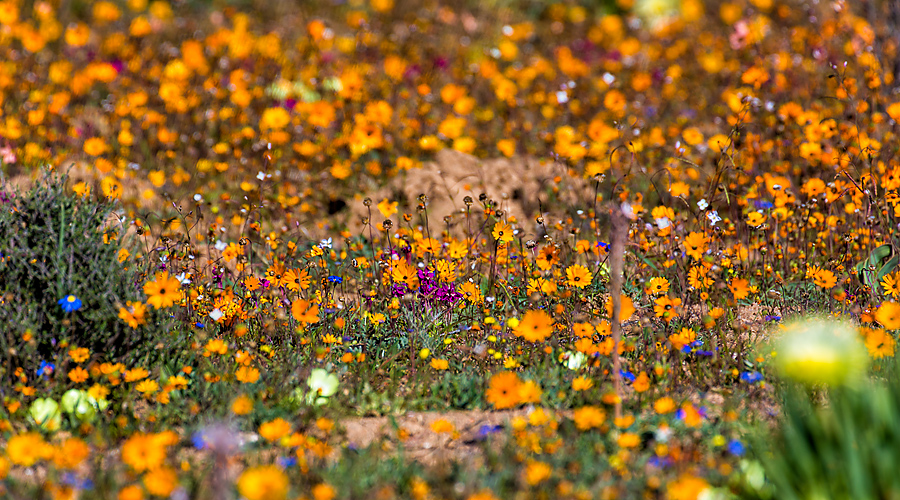

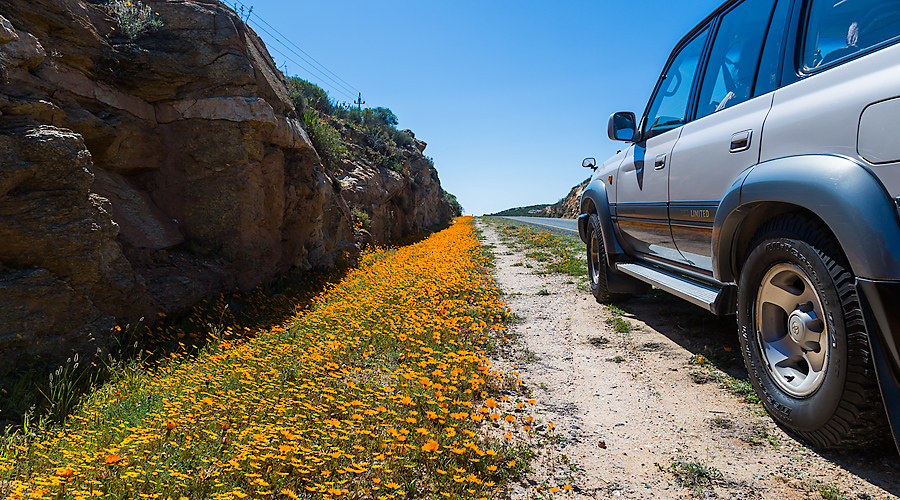
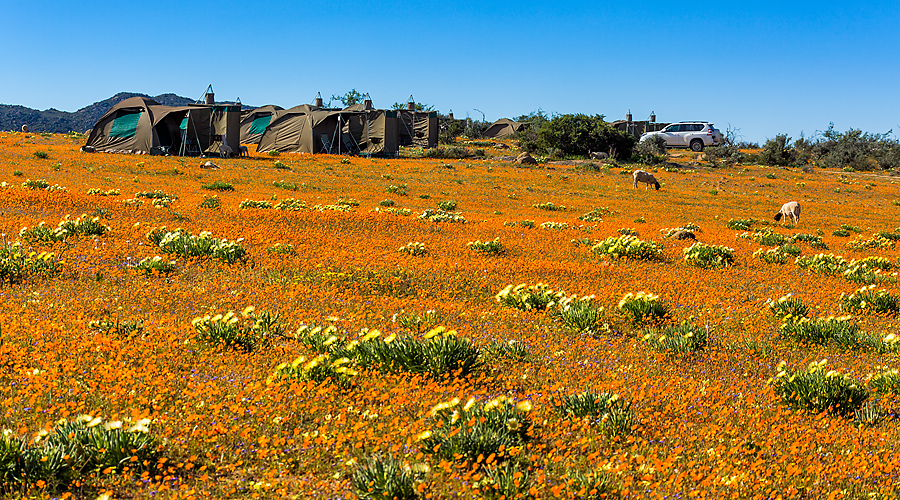
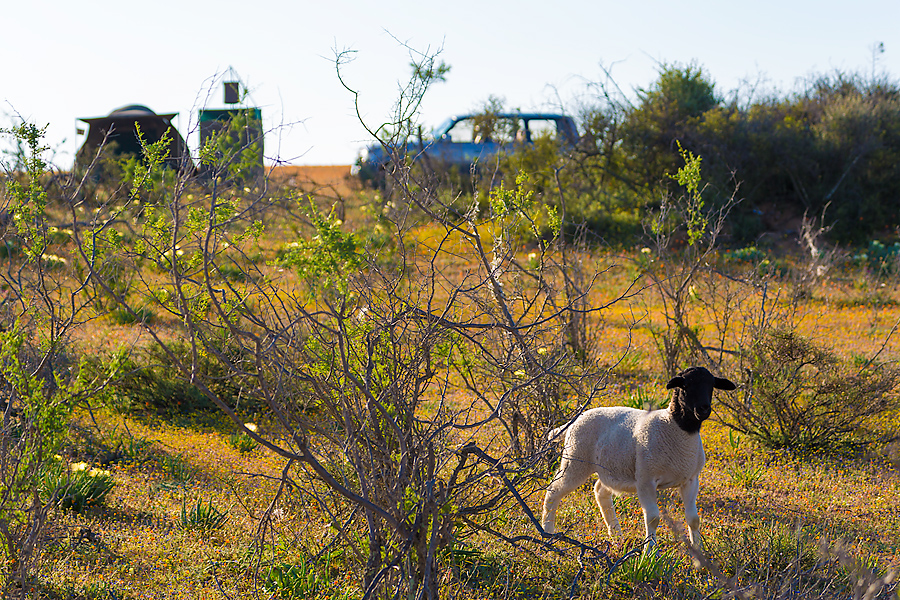
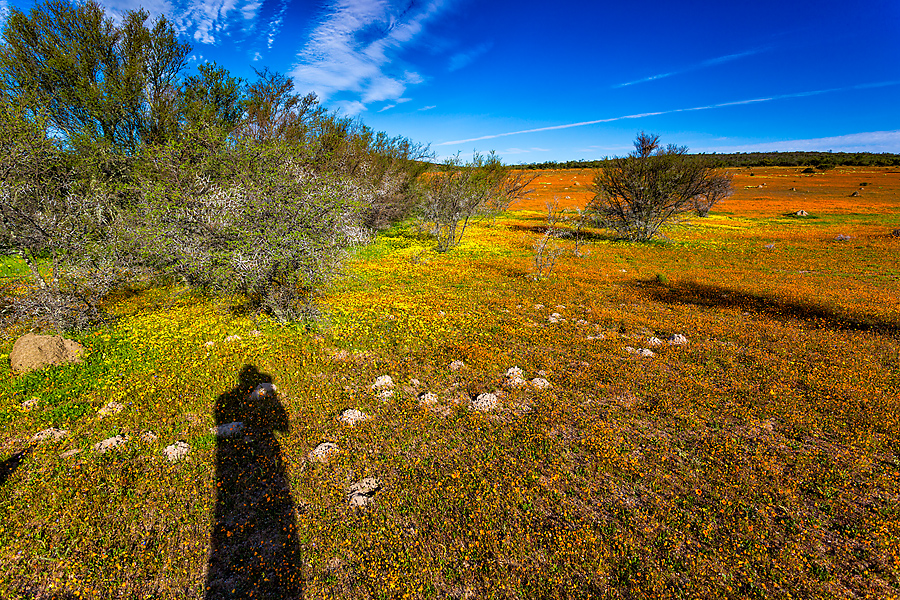
Comments
Germaine Versailles
Marie
Kath
Tara
Vince
Marie
Debbie from MountainMama
Vince